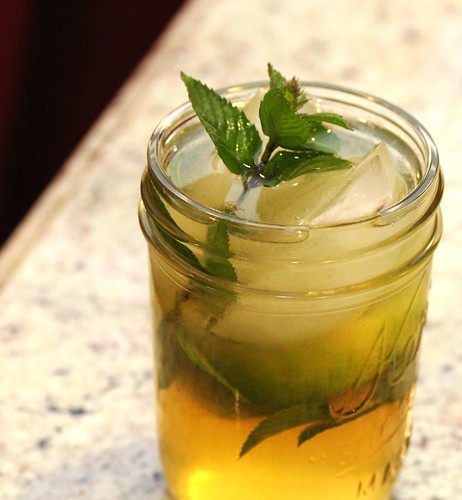I'm not generally a fan of the starches (except homemade bread - I love homemade bread). Baked potato. Mashed potato. Rice. I'm not a huge fan. But when I read the recipe for Morimoto's potato soup, I knew I had to try it (adapted from his
Morimoto: The New Art of Japanese Cooking
). This is one of the best things I have ever cooked.
Morimoto starts out the section with a fairly hilarious quote:
I must confess I have a weakness for luxurious foods like lobster, caviar and foie gras. But I also respect the humbles of ingredients. Their plainness offers me a different kind of challenge. Here a simple potato is transformed into an elegant soup you could serve at any dinner party.
Of course, the recipe also includes
caviar, which certainly helps elevate the humble potato.
First, the broth. The broth is a simple
dashi-based broth. The genius who first decided to boil kelp and fish flakes should be honored with the status of a demi-god.
4 cups water
½ cup loosely packed bonito flakes
1 piece 4x6 inch kombu
1 large baking potato
1 ½ sticks unsalted butter
¾ cup half and half
2 tbsp sake
3 tbsp light-colored soy sauce
salt
1 oz caviar
wasabi
chives
Kombu and bonito flakes are available at Japanese and Korean grocery stores. At H-Mart in Massachusetts, there is a kelp section of the store, where you find the kombu. The bonito flakes (dried, shaved fish flakes) are in the seasoning section. Kombu:
And bonito flakes:
Rinse off the kombu. Place into a pot with the 4 cups water, and bring to a boil. Boil for 10 minutes (until it starts to make your kitchen smell like a wharf), and then remove from heat. Add the bonito flakes, and stir. Allow the mixture to cool (20 minutes or so). Strain the liquid into a different pot to remove the kelp and bonito flakes. Don't be alarmed by the smell, the broth will be delicious.
Meanwhile, take a baking potato, and stab it with a fork a few times.
Steam until soft (20-30 minutes). Remove from heat, and remove the skin from the potato. Mash the potato, and then force it through a potato ricer or a fine sieve.
Heat the butter and cream in a pot until melted. Whisk in the sieved potato. At first it will float around in the cream, but as you continually whisk, it will turn into a syrupy goop. Continue whisking until it has the texture of a polenta.
Meanwhile, reheat the broth. Season with sake and soy sauce, and salt to taste.
When the potatoes come together in a thickened consistency, scoop it into the centre of the bowls you're serving it in (this makes 6 nice appetizers). Pour broth around it. Add a scoop of wasabi, some chives and a scoop of caviar to the potato. Serve.
This will be a repeat in our house. Very super delicious.
By Bbq Dude


